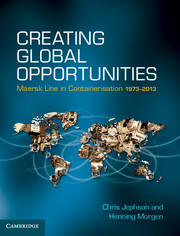Book contents
- Frontmatter
- Dedication
- Contents
- List of figures
- List of tables
- List of Economist Intelligence Unit data
- List of boxes
- Acknowledgements
- Glossary
- Prologue
- 1 ‘Per Aspera Ad Astra’
- 2 The Coming Revolution
- 3 The Decision
- 4 Building the Base (1978–1984)
- 5 Planning the Next Steps (1984–1987)
- 6 Laying the Foundations for Expansion (1987–1990)
- 7 The 1990s
- 8 The Acquisition Trail (1992–1998)
- 9 1999 A Year of Developments and Acquisitions
- 10 Into the New Millennium (2000–2005)
- 11 P&O NedLloyd (2005–2007)
- 12 A New Strategy (2008–2013)
- Epilogue
- Notes and References
- Index
11 - P&O NedLloyd (2005–2007)
A Contentious Acquisition
Published online by Cambridge University Press: 05 April 2014
- Frontmatter
- Dedication
- Contents
- List of figures
- List of tables
- List of Economist Intelligence Unit data
- List of boxes
- Acknowledgements
- Glossary
- Prologue
- 1 ‘Per Aspera Ad Astra’
- 2 The Coming Revolution
- 3 The Decision
- 4 Building the Base (1978–1984)
- 5 Planning the Next Steps (1984–1987)
- 6 Laying the Foundations for Expansion (1987–1990)
- 7 The 1990s
- 8 The Acquisition Trail (1992–1998)
- 9 1999 A Year of Developments and Acquisitions
- 10 Into the New Millennium (2000–2005)
- 11 P&O NedLloyd (2005–2007)
- 12 A New Strategy (2008–2013)
- Epilogue
- Notes and References
- Index
Summary
The merged company will enjoy the critical mass of an alliance, and the ability to differentiate itself by simply being the only carrier big enough to operate entirely on its own.
A. Donovan and J. Bonney, The Box that Changed the World, 2006The first decade of the twenty-first century was turbulent for many, in many different parts of the world and in many different ways. In 2005 the US housing market peaked and the asset bubble that had financed so much of the power of the consumer to keep global markets buoyant started to collapse. On a more positive note, that year the International Monetary Fund approved 100 per cent debt relief for 19 countries under the Multilateral Debt Relief Initiative. The amount involved was relatively small, some $3.3 billion, but a positive step had been taken.
That same year, 2005, the Multi-Fibre Agreement, which had imposed quantitative restrictions on textile movements, particularly from Asia and the less developed areas of the world, came to an end after a long phase-out period. The China effect was beginning to be significant; China’s share of global textile exports to the US and Europe, 17 per cent in 2005, would rise to 40 per cent by 2010.
- Type
- Chapter
- Information
- Creating Global OpportunitiesMaersk Line in Containerisation 1973–2013, pp. 311 - 327Publisher: Cambridge University PressPrint publication year: 2014



